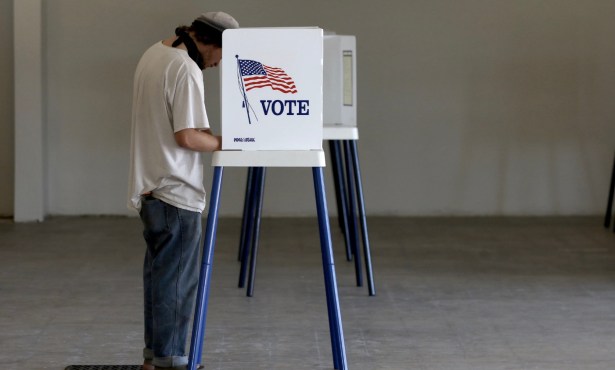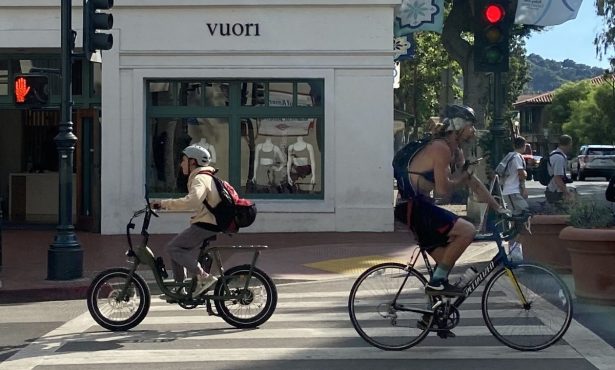Dog Got Your Tongue?
Poodle Searches for God on Bike Path
SCREECHING TO THE CHOIR: Contrary to popular opinion, I do not consider the act of riding a bicycle to be a religious experience. If it were, the skinny-legged fixie crowd would have declared a jihad on the Spandex set years ago. And the mountain bikers would be persecuting everyone else off the road. The remarkable ecumenical good will among the cycling tribes partially reflects the sheer fun of an activity that’s essentially utilitarian. But the other reason, of course, is the automobile. I’m not here to diss the car; after all, I drive one. But back when God invented the bicycle, Man somehow forgot to allocate space on the road to accommodate the two-wheeled beast. We’ve all been paying the price ever since.

I mention this because we are now in the thrall of CycleMAYnia month, featuring all kinds of events — bike fashion shows, bike proms — designed to trigger the proper Pavlovian response among would-be riders who have yet to get off the fence and onto their bikes on their way to work. The operating premise behind this not-so-hidden social agenda is, “Try it; you’ll like it.” This is infinitely better than the old “Eat your vegetables” message of Bike to Work Week, which has since been supplanted by CycleMAYnia. By enticing people to discover that riding to work is often more simple, convenient, and enjoyable than driving, the hope is that they’ll be moved to do so on their own. I have little doubt this approach has garnered converts. But if you really want people to sit down and eat with you, it’s a good idea to provide them a knife and fork, not to mention a place at the table. The simple fact is a whole lot more people would be willing to ride to work if they thought roads were designed with the safety of cyclists in mind. It’s not just that we’re all fat, stupid, and lazy.
To the extent people actually do cycle to work, it’s in spite of, not because of, the system we’ve created. The numbers bear this out. Few places on the planet are as bike-conducive as Santa Barbara when it comes to weather and terrain. Yet only 3 percent of the workforce — countywide — rides to work. In the city, it’s about twice that. Compared to other communities throughout the state and nation, Santa Barbara positively kicks ass. Even with escalating gas prices and the recession, the number of bicycle commuters in Santa Barbara increased by only one percent over the last 10 years. This paltry increase, however, puts Santa Barbara in the top 25 counties nationwide when it comes to increasing the number of bike commuters. Talk about setting the bar low; that’s like pole vaulting over the New Cuyama Yellow Pages.
At the risk of screeching to the choir, bicycle commuting makes obvious sense when considering public health, traffic congestion, climate change, and air pollution. About 40 percent of all car trips in the United States involve distances of two miles or less; 28 percent are half that. Half the country still works within five miles of their home. Obviously, not all these trips can or will be done by bike. But a whole lot could. The opportunity for improvement is vast. As of 2007, the average Santa Barbara bike commute was about three miles; according to the Air Pollution Control District, every bike trip translated into 5.5 pounds of carbon dioxide — and 67 grams of toxic pollutants — that were kept out of the atmosphere. If you’re alarmed there’s now more carbon dioxide in the atmosphere than at any time in the past 5 million years, the bike affords you the opportunity, however tiny, to push the needle back.
Countries like the Netherlands, Denmark, and Germany — where gas is admittedly a lot more expensive — figured this out a long time ago. There, everybody rides, not just young single men with delusions of immortality if not outright godhood, as in the United States. Women ride. Kids ride. Old people ride. And in mass numbers. This didn’t just happen by accident. And back in the ’70s, it didn’t happen at all. Then, roads in these countries were designed for, by, and of the automobile. As a result of public policy and political will, changes were made, space carved out, and roads redesigned with bikes in mind. The punch line of the European experience is that if you build bike lanes, they, in fact, will come. In that vein, I was thrilled to hear City Hall plans to stripe a new bike lane down Haley Street — from Chapala Street to Alisos Street. But most cyclists need more than a stripe of paint to feel safe, particularly where traffic moves faster than 30 miles an hour. Safety, it turns out, is more than a state of mind; it’s a function of design. That’s why the bike riders in the United States are six times more likely than their European counterparts to get killed in a collision with a car. That’s why Santa Barbara ranks third of California’s 58 counties in car-bike collisions. In Europe, they build “green lanes” — with distinctly colored concrete — set aside from the flow of cars by bollards or other barriers. In Santa Barbara, traffic engineers have been forced to take advantage of exceedingly limited opportunities, often with predictably limited results. The Mission Street bike lane was a wonderful example of opportunistic planning ingenuity. But it lasts only a few blocks. When it’s over, riders then find themselves dumped out onto a road so skinny, so chewed up, and so busy that they jump the curb and take to the sidewalks out of self-preservation.
Bicycling may be one of life’s simple joys, but clearly, it should not be confused for a religious experience. Much of this theological confusion could be quickly cleared up, however, if cyclists weren’t forced to worry so much about meeting their maker every time they took to the road.



